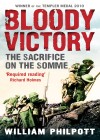Bloody Victory: The Sacrifice on the Somme and the Making of the Twentieth Century
Written by: William Philpott,
Little, Brown, London, 2009,
ISBN 9781408701089, 736pp
Reviewed by: Albert Palazzo, Land Warfare Studies Centre
For most readers the mention of the Somme brings forth the image of a futile and tragic campaign in which a generation of fine British and Imperial soldiery was wilfully slaughtered by an incompetent and distant command. William Philpott, in his breakthrough book Bloody Victory: The Sacrifice on the Somme and the Making of the Twentieth Century, takes on this image and reveals it for what it is—a myth. The result is that in Bloody Victory Philpott has produced a work of revisionist military history at its best.
Philpott’s honesty is both refreshing and the source of his book’s strength. For him there is no doubt that the Somme was not a tragedy. Instead, it was a British and French victory, the campaign in which the armies of Britain and France demonstrated their dominance over their opponent while representing for Germany the onset of a gradual decline from which its forces never recovered. True, it took two more bloody years for the Entente powers to defeat the German Army, but for Philpott the Somme was the turning point. The author does not recoil from the campaign’s huge casualty toll, nor does he moralise about the high losses. Instead, he accepts that in an industrial mass-army war an attrition strategy was unavoidable. In making his case Philpott also challenges another orthodoxy of First World War interpretation. While Entente commanders such as Douglas Haig and Ferdinand Foch were admittedly not military geniuses, Philpott correctly credits them with recognising what was needed to be done and then having the strength of conviction to carry out the unpalatable but necessary task of trading their soldiers’ lives for those of the enemy.
For a military readership Bloody Victory also serves as a case study in adaptation. All too often the Somme is measured by the outcome of its first day, during which the British suffered over 57,000 casualties. By comparison, the story of the next five months is underrepresented in the literature. Yet, as Philpott shows, it is what came after the first day that holds the campaign’s true lessons. For the British the Somme was the beginning of an evolutionary process that transformed raw troops and inexperienced officers into a skilled fighting force that developed the professionalism needed to achieve victory in 1918.
Bloody Victory also breaks with tradition by giving the French Army its just due. English speaking authors tend to write of the campaign from a British perspective, forgetting the major role the French Army had in the battle. French writers, by contrast, prefer to identify with the struggle at Verdun, the other great Western Front contest of 1916. The Somme cost the French over 200,000 casualties and their sacrifice deserves greater recognition than hitherto accorded to them. This work is a useful start to the English language telling of their accomplishments. Philpott also devotes remarkable detail to the performance of the Australian forces in the campaign and includes Australian materials, such as CEW Bean’s writings, amongst his sources.
Despite its length, the reader will find Bloody Victory worth the effort. Some chapters will be of less interest to the military professional, such as those dealing with the memory and interpretation of the battle, but these are also worth attention as they add richness and depth to this fine analysis of the Great War’s critical battle. Bloody Victory should be read by anyone with an interest in the First World War as well as by those for whom warfare is their business.


